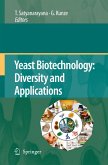Yeasts have a longstanding history as domesticated organisms. The brewing of beer and wine and the leavening of bread dough are well-known 'artisanal' applications of yeast. These early examples of yeast biotechnology have clearly contributed to the acceptance of yeasts, both as biotechnological workhorses and as model systems for the detailed understanding of eukaryotic molecular cell biology and genetics.
In recent years, new yeast species have proven their value and novel biotechnological applications have emerged. This book compiles the multi-faceted genetic repertoire of several yeasts relevant to modern biotechnology, and describes their utilization in research and application in the light of their genetic make-up and physiological characteristics. Moreover, the book presents a thorough overview of a wide array of methodologies from classical genetics to modern genomics technologies that have been and are being used in functional analysis of yeasts.
Hinweis: Dieser Artikel kann nur an eine deutsche Lieferadresse ausgeliefert werden.
In recent years, new yeast species have proven their value and novel biotechnological applications have emerged. This book compiles the multi-faceted genetic repertoire of several yeasts relevant to modern biotechnology, and describes their utilization in research and application in the light of their genetic make-up and physiological characteristics. Moreover, the book presents a thorough overview of a wide array of methodologies from classical genetics to modern genomics technologies that have been and are being used in functional analysis of yeasts.
Hinweis: Dieser Artikel kann nur an eine deutsche Lieferadresse ausgeliefert werden.
From the reviews:
"In this book the multi-faced genetic repertoire of several yeasts relevant to modern biotechnology ... is compiled and their utilization in research and application is described in light of their genetic make-up and physiological characteristics. ... References for all chapters are also numerous and up-dated. The book serves a wide audience ranging from the interested graduate students, via the experienced academic researcher, to the biotechnological industry." (Bianca Maria Ranzi, Annals of Microbiology, Vol. 54 (1), 2004)
"In this book the multi-faced genetic repertoire of several yeasts relevant to modern biotechnology ... is compiled and their utilization in research and application is described in light of their genetic make-up and physiological characteristics. ... References for all chapters are also numerous and up-dated. The book serves a wide audience ranging from the interested graduate students, via the experienced academic researcher, to the biotechnological industry." (Bianca Maria Ranzi, Annals of Microbiology, Vol. 54 (1), 2004)









